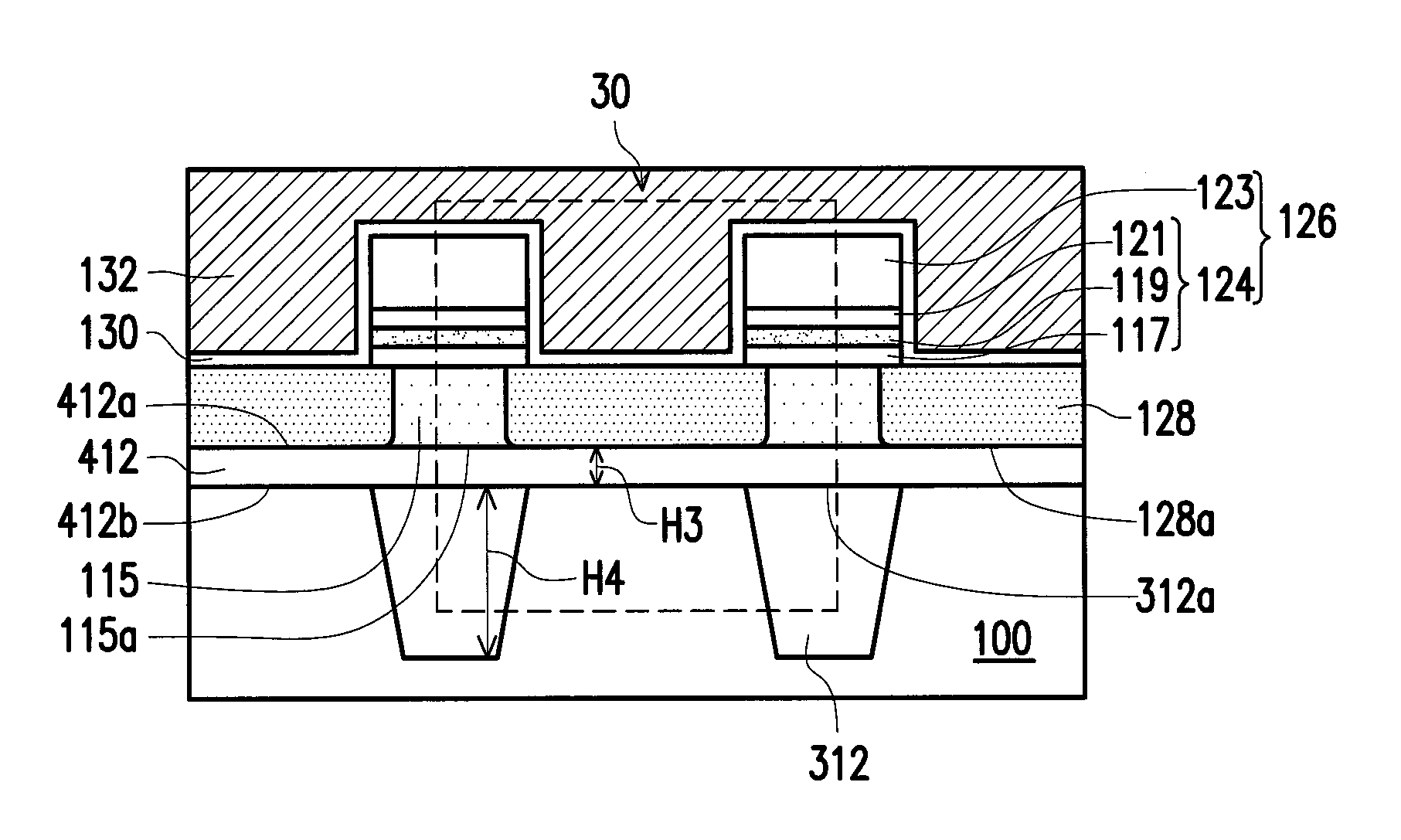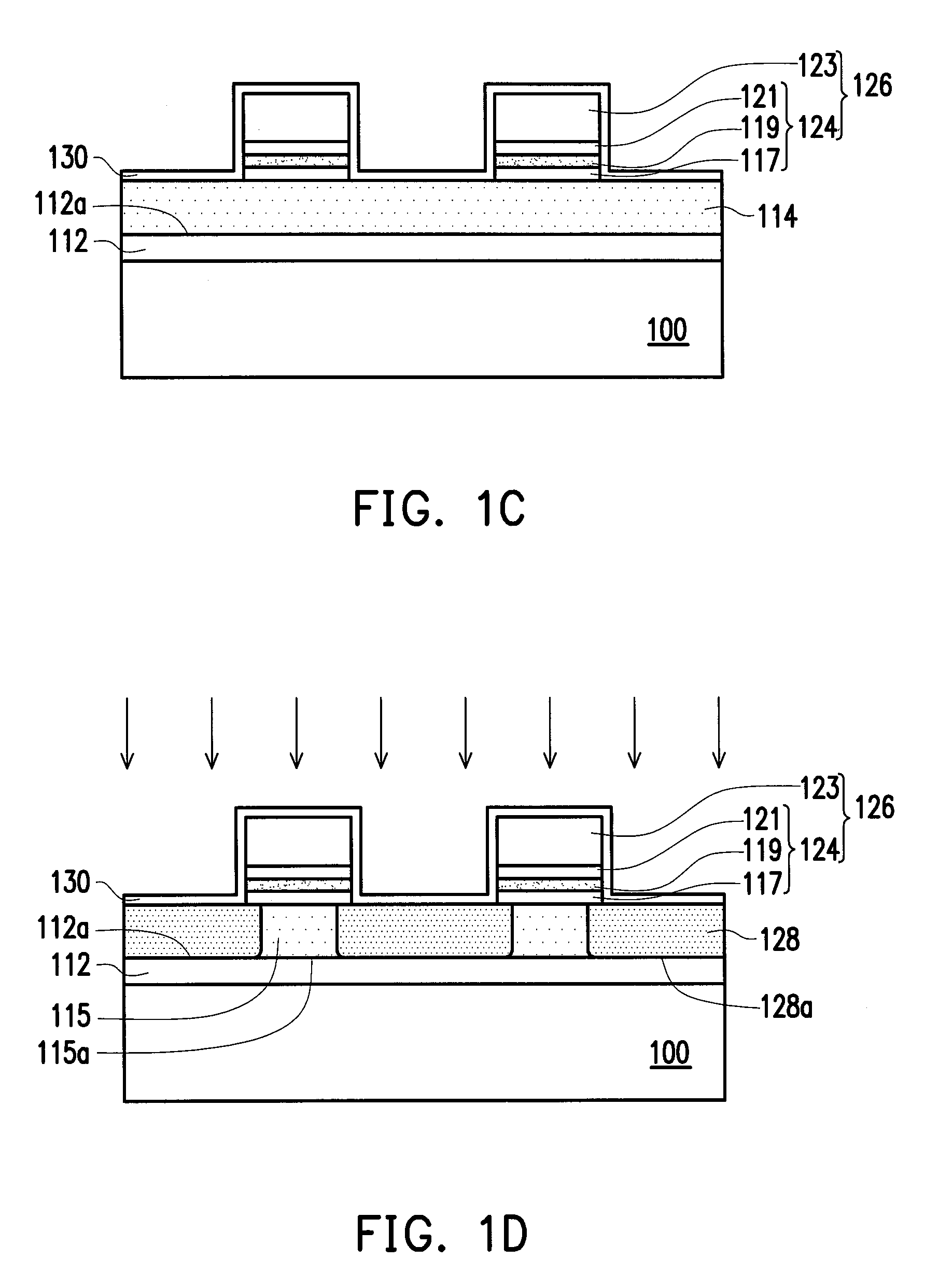Memory cell and manufacturing method thereof
a memory cell and manufacturing method technology, applied in the field of memory cells, can solve the problems of reducing the performance of the memory, flash memory may suffer from affecting the reliability of the device, etc., and achieve the effect of reducing the generation of a second bit effect and program disturbance during operation
- Summary
- Abstract
- Description
- Claims
- Application Information
AI Technical Summary
Benefits of technology
Problems solved by technology
Method used
Image
Examples
first embodiment
[0038]FIG. 1A to FIG. 1E are schematic cross-sectional diagrams of a manufacturing process of a non-volatile memory device illustrated according to the invention.
[0039]In the following, the first conductivity type is N-type and the second conductivity type is P-type for illustration. However, the invention is not limited thereto. Those having ordinary skill in the art should know that the first conductivity type can also be changed to P-type and the second conductivity type be changed to N-type. In particular, the N-type dopant is, for instance, phosphorous or arsenic, and the P-type dopant is, for instance, boron or boron difluoride (BF2).
[0040]First, referring to FIG. 1A, an isolation structure 112 is formed on a substrate 100. The substrate 100 can be formed by at least one semiconductor material selected from the group consisting of Si, Ge, SiGe, GaP, GaAs, SiC, SiGeC, InAs, and InP. The material of the isolation structure 112 is, for instance, any suitable material such as sili...
second embodiment
[0054]FIG. 2A to FIG. 2E are schematic cross-sectional diagrams of a manufacturing process of a non-volatile memory device illustrated according to the invention. The manufacturing process of the semiconductor device of FIG. 2A to FIG. 2E is similar to the manufacturing process of the non-volatile memory device of FIG. 1A to FIG. 1E, and therefore the same elements are represented by the same labels and are not repeated herein.
[0055]First, referring to FIG. 2A, a plurality of isolation structures 212 are formed in a substrate 100. In the figure, only two isolation structures 212 are illustrated. A depth H2 of each of the isolation structures 212 is, for instance, 500 angstroms to 3000 angstroms. The material of the isolation structures 212 is, for instance, any suitable material such as silicon oxide, silicon oxynitride, silicon carbide, or silicon carbon nitride. The forming method of the isolation structures 212 is, for instance, a shallow trench isolation method or a deep trench ...
third embodiment
[0061]FIG. 3A to FIG. 3F are schematic cross-sectional diagrams of a manufacturing process of a non-volatile memory device illustrated according to the invention. The manufacturing process of the semiconductor device of FIG. 3A to FIG. 3F is similar to the manufacturing process of the non-volatile memory device of FIG. 1A to FIG. 1E, and therefore the same elements are represented by the same labels and are not repeated herein.
[0062]First, referring to FIG. 3A, isolation structures 312 are formed in a substrate 100. The material of the isolation structures 312 is, for instance, any suitable material such as silicon oxide, silicon oxynitride, silicon carbide, or silicon carbon nitride. A depth H4 of each of the isolation structures 312 is, for instance, 500 angstroms to 3000 angstroms. The forming method of the isolation structures 312 is, for instance, a shallow trench isolation method or a deep trench isolation method.
[0063]Then, referring to FIG. 3B, an isolation structure 412 is ...
PUM
 Login to View More
Login to View More Abstract
Description
Claims
Application Information
 Login to View More
Login to View More - R&D
- Intellectual Property
- Life Sciences
- Materials
- Tech Scout
- Unparalleled Data Quality
- Higher Quality Content
- 60% Fewer Hallucinations
Browse by: Latest US Patents, China's latest patents, Technical Efficacy Thesaurus, Application Domain, Technology Topic, Popular Technical Reports.
© 2025 PatSnap. All rights reserved.Legal|Privacy policy|Modern Slavery Act Transparency Statement|Sitemap|About US| Contact US: help@patsnap.com



